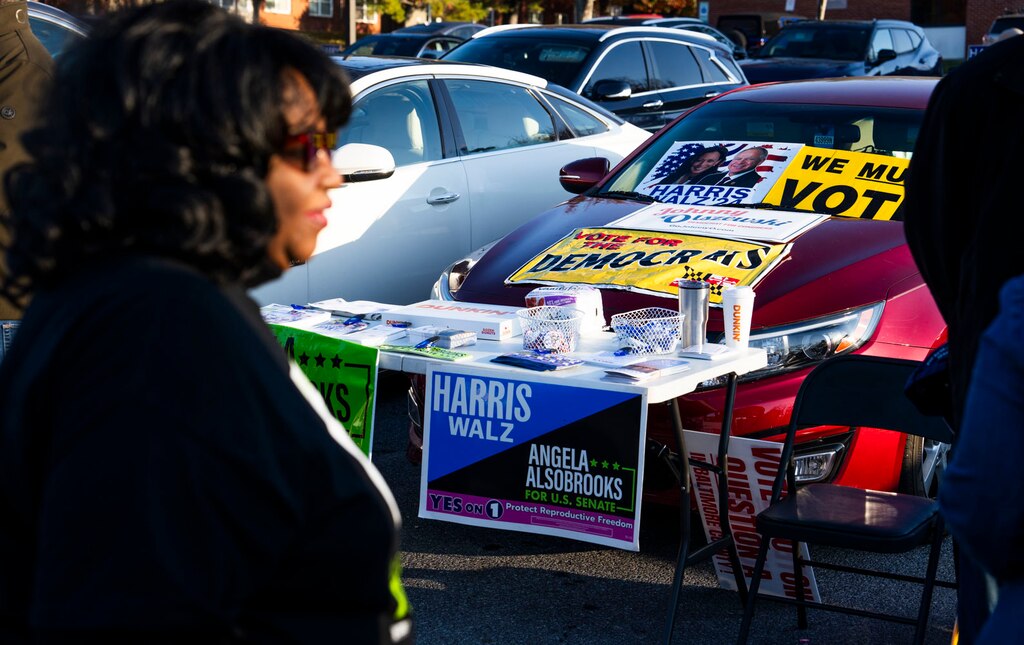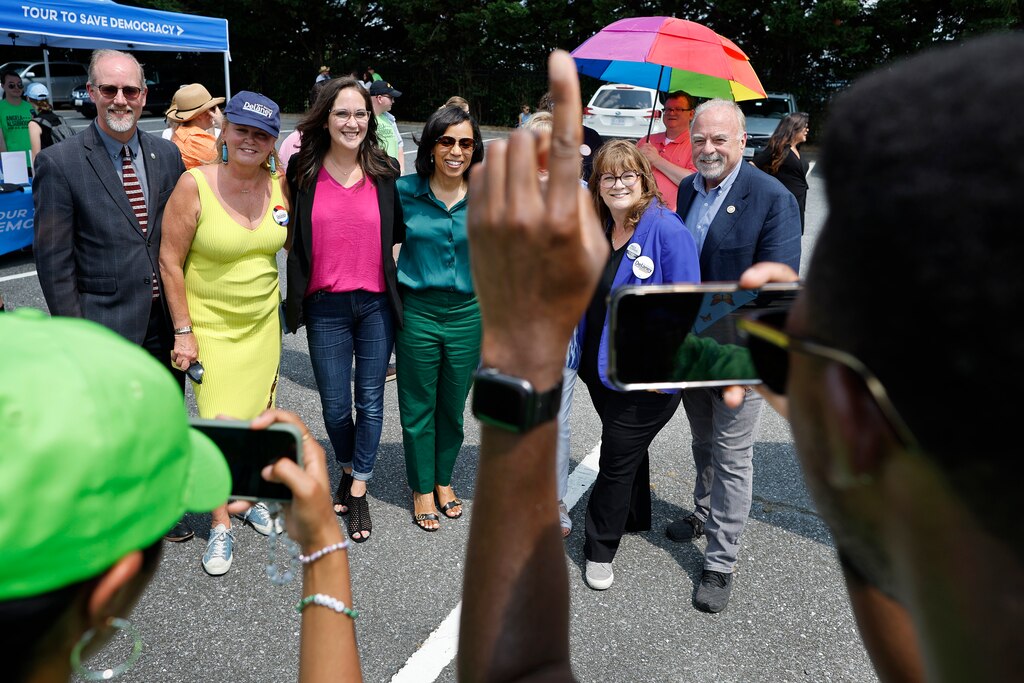More than one in five Maryland voters are choosing not to register with a party — a 25% increase since 2012, according to an analysis of state voter data, as more voters express dissatisfaction with Democrats and Republicans.
Those growing unaffiliated voters could be crucial in Maryland’s U.S. Senate race, in which Democrat Angela Alsobrooks, the Prince George’s County executive, and Republican former Gov. Larry Hogan have told voters the race is a choice between the consequences of party control and independence.
By the numbers, the state’s more than 907,000 unaffiliated voters are just a fraction of the 2.2 million Democrats who dominate Maryland’s political landscape. But unaffiliated voters are creeping up on the state’s 1 million Republicans as the second-largest group of voters.
The shift likely has major implications on who gets nominated in future elections as more and more voters opt out of participating in Maryland’s closed primaries and partisans gain power. Think fewer moderates like Hogan and more firebrands like 2020 GOP gubernatorial nominee Dan Cox.
“There’s this perception about Maryland as a noncompetitive state,” said Derek Willis, a professor at the University of Maryland, who analyzed the state-compiled data for The Baltimore Banner. “It’s still pretty weird. We do some stuff other states don’t do.”
The expansion of unaffiliated voters spans Maryland’s geographical regions. Willis found the state’s fastest-growing counties such as Charles and Dorchester saw increases, while in Howard County a bump was accompanied by a decline in Republican registration. The state’s most staunch Democratic strongholds also saw the shift. Since 2012, unaffiliated voters have increased by 37% in Baltimore while both major parties have lost voters.
Willis pointed to growing hostility among Marylanders and Americans toward institutions and partisan politics as a driver behind the movement.
“If I’m a Republican or a Democrat generally speaking, but I don’t agree with what’s been going on in national politics for the last eight years, maybe you just say the way of protesting that is I’m going to make myself an independent, unaffiliated voter,” Willis said.

Quintin Dorsey, 35, took that leap. As he waited in line to vote at the Odenton Library on Thursday, Dorsey said he initially registered as a Democrat but opted to become independent. He pointed not to general disgust with partisanship but to the teachings of Malcolm X, who warned against aligning with political parties.
“You should go with who is providing the best tangibles,” Dorsey said.
In this election, that means he’s voting for Democrats over Republicans, whom he called “far-right fascists.”
Research shows Dorsey is in good company. Although Maryland voters are increasingly unaffiliated, most maintain a partisan allegiance when it comes time to cast a ballot, Willis said.
That maxim holds less firm in Frederick County. Once a comfortably red outpost, Willis said, the Western Maryland county has become the state’s “most politically diverse electorate.” Frederick is the only jurisdiction where the voter shares of Democrats, Republicans and independents fall within 12 points of each other, making unaffiliateds a bona fide voting bloc and a potentially decisive group in this year’s election.
To former Republican state Sen. Mike Hough, the rise of the unaffiliated voter in Frederick may be a good thing for the local GOP, because it suggests a class of voters that his party can reach even as his county turns increasingly purple.
The former lawmaker, who lost to Democrat Jessica Fitzwater for Frederick County executive in 2022, pointed to the wave of newcomers to Frederick as the driving force behind the independent surge. The fastest-growing county in Maryland, Frederick added some 60,000 residents from 2010 to 2023.
The group includes plenty who have strong political opinions but don’t want to side with either party, Hough said, though he thinks it skews younger and tends to be less politically engaged. To win Frederick County these days, Hough said, a candidate needs to take 15% to 20% of the independent vote — something he was unable to pull off in 2022 but which he expects Hogan is well positioned to do.
On the other side of the aisle, Democratic Del. Kris Fair said he thinks the local independent crowd is more sympathetic to his party’s arguments. The group tends to include two types of people, Fair said: older voters who might have conservative leanings on the economy but more progressive social mores, and younger people who are frustrated with the strictures of the two-party system.
By and large, though, the independents Fair meets share progressive social values in common with Democrats.

Still, local Democrats shouldn’t get complacent about this oft-forgotten voter bloc, Fair said. “There’s a reason why people are filing unaffiliated and not with either major party, and we should be looking internally to figure out why that is.”
Some independent voters in Fair’s county backed up his assessment, expressing exasperation with partisan politics even as they admitted they lean Democratic on their primary issues.
“I kind of see all politicians as liars,” 28-year-old Lee Simpson said as she approached a long line at an early voting site in the city of Frederick. “I prefer to remain independent so I can remain a true neutral party and pick which bullshit I’m gonna buy into.”
Above any other issue, Simpson cares about gun control. Casting a ballot in the presidential race for Kamala Harris was an easy decision for Simpson, but even as she approached the polls she was weighing what to do about the U.S. Senate race.
Hogan wouldn’t get her vote, Simpson said, but she hadn’t decided yet whether to pull the lever for Alsobrooks.
Other counties where the percentages of Democrats, Republicans and unaffiliated voters are merging include Anne Arundel, Calvert and Harford.
Todd Eberly, a St. Mary’s College of Maryland political science professor, said unaffiliated-rich counties like Frederick are a “must-win” for Hogan, as the Republican former governor tries to best Alsobrooks.
Hogan’s campaign advertising makes that apparent, Willis added. His television spots suggesting voters split their tickets are a direct appeal, he said.
“That’s entirely Hogan’s target,” he said. “He’s like ‘All these guys suck. Join me in hating on them, and vote for me, rebuking them.’” Most of the unaffiliated voter growth has happened since Hogan first ran for governor in 2014.
During a campaign stop in Annapolis last week, Hogan acknowledged that independent voters are a critical demographic. “They don’t vote as often, because they’re not as partisan or engaged,” he said. “But they’re really important.”
Hogan’s strategy has worked before. He secured two terms as governor by keeping nearly all Republican votes, winning a majority of independents and convincing one-third of Democrats to vote for him. But, as major party registrations tick downward and unaffiliated registrations increase, the Republican Party of Maryland will see the most immediate effects, Eberly and Willis said — particularly if Hogan is unsuccessful.
Maryland’s closed primary system bars unaffiliated voters from participating. That leaves the most staunch, loyal and often extreme members of each party to pick the nominees, they said.
The Republican Party, smaller than the Democratic contingent, has felt those changes acutely. Republican voters nominated the right-leaning Cox over Hogan’s handpicked successor, Kelly Schulz, for governor in 2022. Cox was then handily defeated that fall when the general electorate weighed in.
Even if more extreme candidates survive general elections, they take office with no mandate to govern, Eberly said.
“Good luck getting your agenda through,” he said. “People get frustrated that things aren’t happening, and it just drives them even more to be independent and unaffiliated.”
Republicans may feel the more immediate effects, but Democrats shouldn’t be complacent, Willis warned. They too will be more likely to nominate candidates unattractive to a general election audience.
“Democrats may not always get so lucky,” he said. “I think it would be hubristic for Democrats to celebrate this.”


Comments
Welcome to The Banner's subscriber-only commenting community. Please review our community guidelines.